Matt Le Tissier made the last of his 540 appearances for Southampton on January 30th, 2002 – the only club the mercurial talent played for in his senior career. He never won a trophy or finished higher than seventh in the Premier League, but is a Saints legend revered by fans on the south coast and beyond. We look back at pivotal and classic moments in his career to find out why.
The First Goal
Southampton 4-1 Manchester United (November 4, 1986)
Having arrived in Southampton from the Channel Islands on the YTS scheme in 1985, Le Tissier turned professional the following year, getting his debut in a 4-3 First Division defeat to Norwich. But he announced himself properly in a Littlewoods Cup third-round replay at home to Manchester United that November, less than a month after his 18th birthday.
The Red Devils were in turmoil under Ron Atkinson at the time but were still one of the biggest clubs in the land. George Lawrence and Danny Wallace had given Saints a two-goal lead before Le Tissier emerged as a second-half substitute. No one could truly know at the time, but his first competitive goal as a pro was a signal of intent. Attacking the Milton Road end – which has always been a contender for strangest-looking stands in football, with its shallow lower tier tailing off towards the far end, and a steeper triangular bank stuck on top over two-thirds of it – he unleashed a delicious left-footed lob from just outside the area that left Chris Turner utterly helpless.
He followed that up later with a back-post header from a corner to seal a result that would be significant for both teams. The very start of the Le Tissier era on the south coast also ushered in a new one at Old Trafford, with the beleaguered Ron Atkinson sacked two days after the humiliating trouncing, to be replaced by Alex Ferguson. United fans should form an orderly queue to offer their thanks.
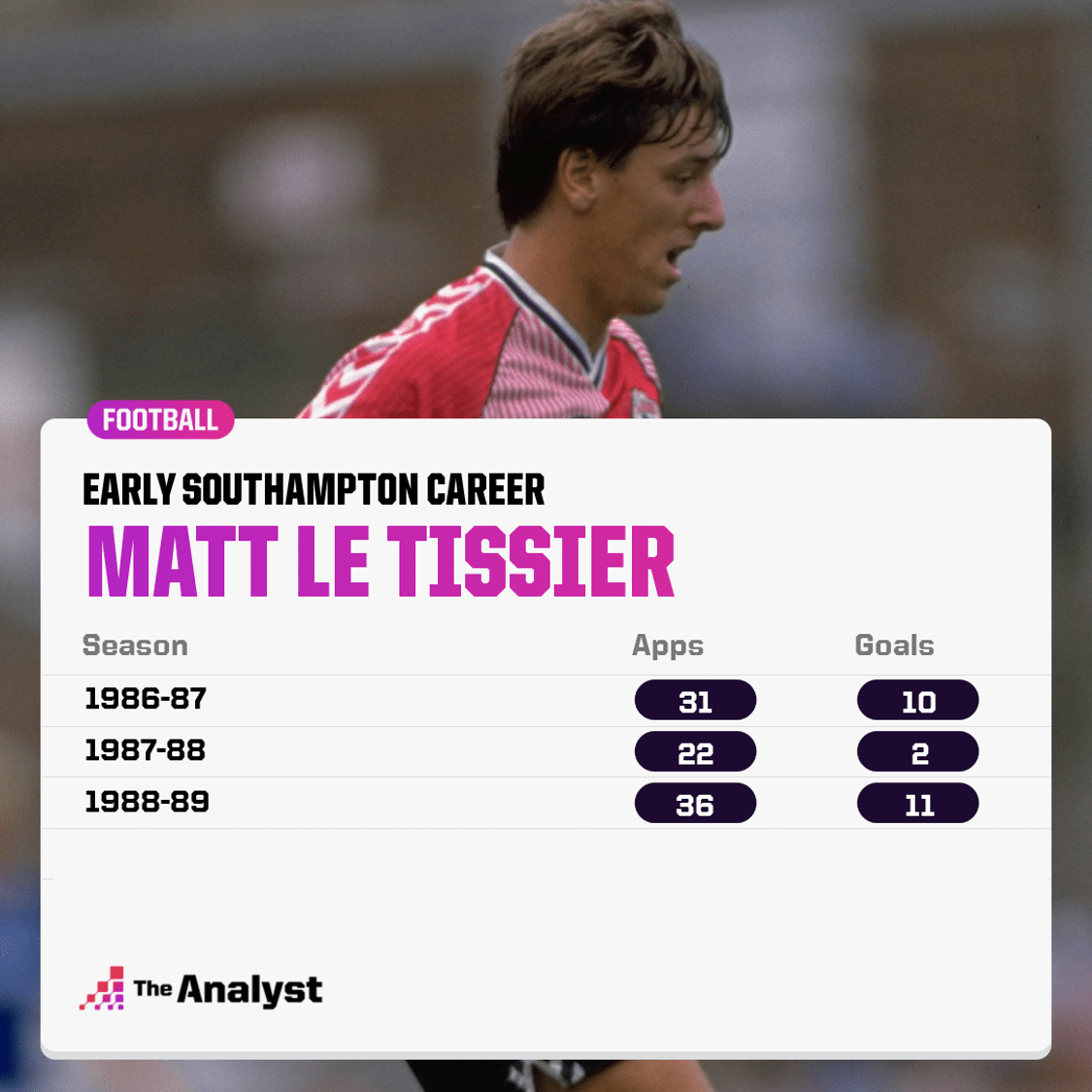
In his debut campaign, Le Tissier made a total of 13 starts and 18 substitute appearances in all competitions, scoring a very promising 10 goals. But after a couple of seasons where development on that initial burst was at the sort of pace he’d later become criticised for, it would take the mercurial youngster a while before he finally found his feet in the top flight.
The One With the Coming-of-Age Hat-Trick
Southampton 4-1 Norwich (February 27, 1990)
And so it was during the 1989-90 season when Le Tissier truly came of age. For the first time, manager Chris Nicholl made him a regular fixture in Southampton’s side, starting 35 matches. And he rewarded him by netting 20 First Division goals – almost a third of Saints’ total that term. His performances were enough to win him the league’s Young Player of the Year award.
While his first wasn’t much of a standout, albeit involving some close control in a crowded box, it’s very possible Barcelona legend Xavi was thinking of the second goal when describing why Le Tissier was his footballing idol when he was growing up:
“He could simply dribble past seven or eight players, but without speed — he just walked past them,” the three-time Ballon d’Or finalist said. “For me he was sensational.”
Le Tissier’s third was almost as good, making a mockery of the idea that he was always slow. It was just that, as Xavi alluded, he so rarely needed pace to beat players. But on this occasion he was set free by a slightly hopeful ball out of defence from Francis Benali, and with one touch took the only Norwich defender in sight completely out of the game. Sprinting onto the ball, his second touch was a perfect lob over Bryan Gunn.
With Le Tissier as their leading scorer, Southampton finished seventh that season – their highest position since coming fifth in 1984-85. It would be their best campaign with Le Tissier in the side.
The One With the Missed Penalty
Southampton 1-2 Nottingham Forest (March 23, 1993)
Everyone knows Le Tissier was deadly when it came to penalties. He scored a total of 47 competitive spot kicks in his career, 25 of which came in the Premier League – putting him sixth on the list of penalty scorers in the competition’s history. But there was one blemish on his one record, which makes Mark Crossley the answer to a very niche trivia question, in the days when we can all go to the pub again.
When Carl Tyler was adjudged to have tugged back Nicky Banger in the box, what came next felt like a foregone conclusion. Le Tissier confidently ran up and hit the ball to Crossley’s right, but at what commentators are contractually obliged to refer to as “a nice height for the keeper”. The rebound fell to the taker, but in his surprise he was only able to turn it over the bar.
25 years ago, to the very day: Matt Le Tissier’s 100% penalty record is spoiled forever by Mark Crossley at The Dell pic.twitter.com/w2dq5He2kw
— Adam Hurrey (@FootballCliches) March 24, 2018
The Saints man did beat Crossley from much longer range later on in the game with a spectacular left-footed volley, but it was a mere consolation as the hosts fell to goals from Nigel Clough and Roy Keane.
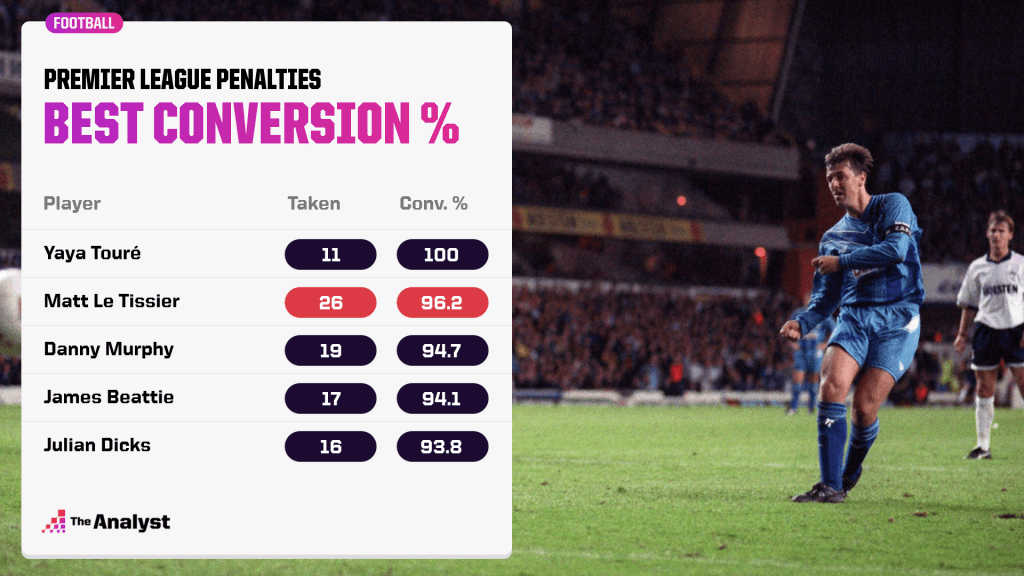
Le Tissier’s spot kick conversion rate of 96.2% in the Premier League remains the competition’s second-best among all players to take 10 or more penalties, behind only Yaya Toure.
The Newcastle Game With the Ridiculous Goals
Southampton 2-1 Newcastle (October 24, 1993)
Ian Branfoot wasn’t exactly a popular manager amongst Saints fans, who staged repeated protests against his tenure, booed his name when it was announced over the tannoy at a Wembley Cup final (the Zenith Data Systems Cup, so don’t get too carried away), put his face on the front of a fanzine under the headline “Hope you die soon”, and reportedly hatched a plot to kidnap him. Mostly, the anger was down to the terrible style of football he employed, which was a marked contrast to the free-flowing Chris Nicholl days supporters had been used to. Results certainly didn’t help, with his period seeing Southampton inappropriately proposition relegation, rather than just flirt with it. There was also the time he tried to appease fans upset at the sale of their star striker Alan Shearer by insisting that the ageing combination of David Speedie and Kerry Dixon would score more goals in the following season (spoiler alert: they didn’t).
His treatment of the club’s other clear talent, Le Tissier, didn’t help matters. After seven defeats from the first eight league games, Branfoot dropped the mercurial Channel Islander in favour of the talents of Paul Moody, on the grounds that the former’s effort levels weren’t good enough. Two draws and another loss followed, as well as a two-legged second round League Cup defeat to third division Shrewsbury, all without Le Tissier even in the matchday squad. Sitting second-bottom in the table, Branfoot eventually bowed to public pressure and reinstated Le Tissier to the starting line-up for a televised Sunday afternoon game against Kevin Keegan’s Newcastle.
Decent brace.pic.twitter.com/Pr6kAVSXzm
— Matt Furniss (@Matt_Furniss) January 29, 2021
With an hour gone and the game still goalless, Moody started warming up. But then came a moment of genius to change the mood of the season. A hopeful ball up from defence was headed in-field by Iain Dowie. It was misplaced, of course, slightly behind Le Tissier, which forced him to improvise, reaching back to flick the ball forward in just enough of an uncontrolled-looking manner to convince Barry Venison he could intervene. His lunge forward allowed the Southampton man to flick it past the defender, enticing Kevin Scott to attempt to cover for his stranded teammate. The third touch was far more controlled, lifting the ball over Scott’s head, reducing him to the part of confused onlooker. Rushing past him into the box, Le Tissier composed himself and appeared to calmly place the ball beyond on-rushing Newcastle keeper Mike Hooper, who was so thoroughly beaten that he could only sit on the ground. In the dugout, Branfoot was shown by the TV cameras telling Moody to sit back down. Le Tissier later admitted he’d scuffed the shot, but that couldn’t take any gloss off the work of art everyone knew they’d just witnessed. From poor pass to shot, the ball only touched the ground once.
Back on Earth, Andy Cole equalised 10 minutes later and Saints were again facing the prospect of dropped points. But three minutes from time Neil Maddison headed the ball in Le Tissier’s direction. A few yards outside the box, he took the ball on his right thigh, before swivelling slightly on the spot. Without letting the ball hit the ground, he unleashed a right-footed volley that flew over Hooper and into the goal.
Two goal of the season contenders in the space of half an hour meant Branfoot didn’t leave Le Tissier out of the team again. But with the club looking doomed to relegation, he was finally sacked the following January.
The Alan Ball Renaissance
Southampton 4-2 Liverpool (February 14, 1994)
World Cup winner and club legend Alan Ball was the man tasked with saving Saints from the mess Branfoot left behind. With Southampton sitting second-bottom, it was going to be an uphill task, but the new boss was in no doubt as to how they would get out of trouble, and issued a simple instruction to his new charges: get the ball to Le Tissier.
“I told them he was the best player in the club; I told them he was the best player in England; I told them he’s maybe the best player in Europe,” Ball said later.
His first game in charge saw a 2-1 win over Newcastle, with Le Tissier scoring the winner from a free-kick – one of seven he managed in his Premier League career, a number only this season surpassed for Southampton by James Ward-Prowse. Le Tissier also scored in the next league match – a 2-1 defeat at Oldham that quickly brought everyone at the club back to the reality of their situation.
And then high-flying Liverpool came to The Dell for a televised Monday night game on a snowy Valentine’s Day. Fewer than 30 seconds had elapsed when Le Tissier – now sporting the captain’s armband – ran onto a poor defensive header and unleashed a 20-yard half-volley past Bruce Grobbelaar.
😍 @mattletiss7 😍
— Southampton FC (@SouthamptonFC) February 14, 2019
This is our sort of #ValentinesDay! Relive all the goals, as #SaintsFC beat #LFC 4-2 #OnThisDay in 1994: pic.twitter.com/Et0Zvv336M
Making his second debut for Saints, Craig Maskell doubled the advantage just five minutes later from a Le Tissier corner and was then brought down for a penalty just before the break. The skipper put the spot kick in the top right-hand corner, his expression immediately after belying more than a hint of relief. Five minutes into the second half, Le Tissier earned another penalty, flicking the ball against ex-Saint Mark Wright’s arm. He went the same way, but in a more secure fashion, to complete the hat-trick – one of four he hit in the Premier League in his career, which is a number yet to be beaten by a midfielder.
3 – Only two players have scored Premier League hat-tricks on Valentine’s Day – Matt Le Tissier in 1994 (Southampton vs Liverpool) and Michael Owen in 1998 (Liverpool vs Sheffield Wednesday). Generous. #Valentines pic.twitter.com/Betb4MCdYv
— OptaJoe (@OptaJoe) February 14, 2019
The new captain rewarded Ball’s faith with six goals in his first four games in charge, marking a new chapter in both Southampton and their talisman’s stories.
The Other Hat-Trick Against Norwich
Norwich 4-5 Southampton (April 9, 1994)
Ball would lead Southampton to safety, but it was anything but comfortable. The Liverpool win was followed by victory over Wimbledon, but then Saints went on a run of three draws and four defeats and things were starting to get desperate. What followed was an incredible topsy-turvy game at Carrow Road as Ball’s men fell behind three times to a side that a few months earlier was beating Bayern in Munich yet came back for a vital win. Unsurprisingly, Le Tissier was at the heart of it.
With Mark Robbins’ strike having been cancelled out by a Robert Ullathorne, a scrappy first half gave little indication of the drama to follow. Within 10 minutes of the restart the hosts were 3-1 up thanks to efforts from Jeremy Goss and Chris Sutton. But just three minutes later, Le Tissier pulled one back – he didn’t make great contact with a left-footed effort from the edge of the area, but somehow Bryan Gunn failed to keep it out. It wasn’t the weakest of his 28 Premier League goals from outside the area – that one squirmed through Massimo Taibi’s hapless hands and legs at Old Trafford in 1999 – but perhaps belongs in the category of ‘well, they all count, don’t they?’.
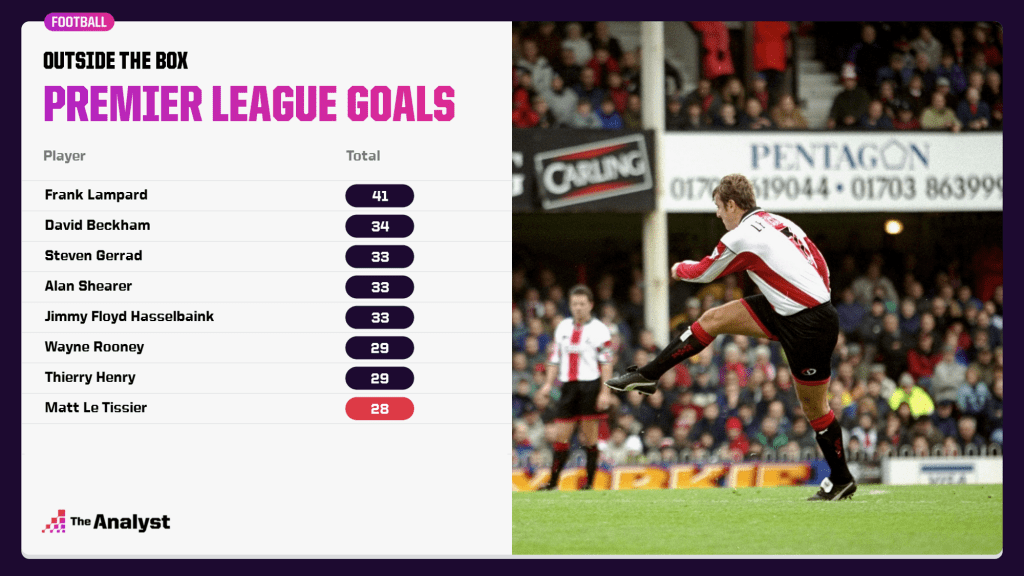
Within another five minutes Jeff Kenna was felled in the box, and we already know what Le Tissier did with penalties. But parity lasted less than 60 seconds, with Sutton looping a header over Dave Beasant to put Norwich ahead once more. Saints kept pressing though and when Jeff Kenna sent over a cross, Le Tissier was on hand at the back post to head home and complete a perfect hat-trick. It was one of nine headed goals he scored in the Premier League.
The day’s drama wasn’t done, as a last-minute Le Tissier corner was met by Ken Monkou’s head as Southampton earned a priceless win. They would finish the (22-team) season in 18th, just one point above relegated Sheffield United.
You can watch the highlights from this nine-goal thriller, here.
The One With the Goal of the Season
Blackburn 3-2 Southampton (December 10, 1994)
During Alan Ball’s time at Southampton, it felt like the shackles had been removed from the club, and particularly from Le Tissier. He relished the responsibility of the captaincy, producing some of his best football in that season and a half. Having survived by the skin of their teeth, the 1994-95 season was far more comfortable, ultimately ending with Saints finishing tenth.
Even if the team was doing better, they were still a collection of largely forgotten also-rans. All except their exceptional skipper, that is. During the 18 months of Ball’s reign, Le Tissier’s numbers are phenomenal. He scored 34 Premier League goals, which was second only over that timeframe to Alan Shearer’s 44. But he didn’t just score goals, he made them, providing 23 assists in the league – six more than second-best Darren Anderton – meaning he led the competition for direct goal involvements over that timeframe.
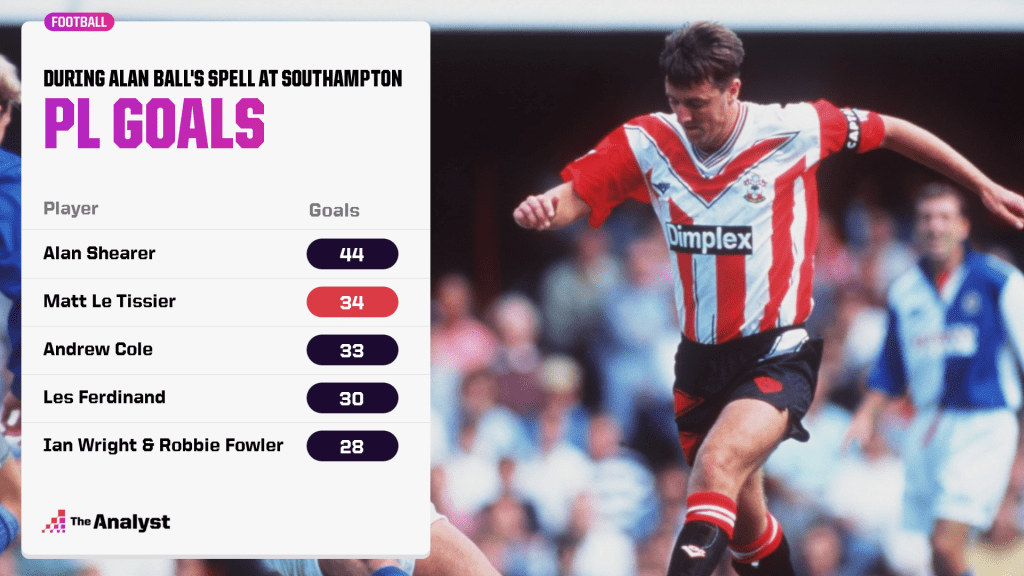
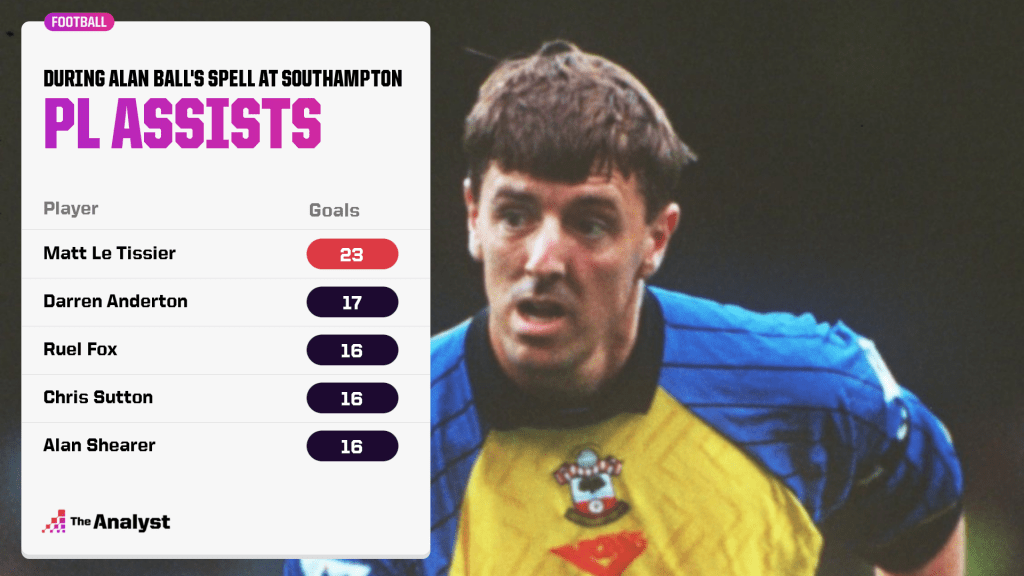
Some 14 of Le Tissier’s goals in that period came from outside the box – more than twice as many as the next-best, which was Shearer and Robbie Fowler with six each. The best of them came on a trip to Blackburn. These days Southampton are known for having their most promising talent sold to Liverpool, but in 1994-95 the Rovers team on its way to the title contained Shearer and ‘keeper Tim Flowers, both of whom had been bought from the Saints for big money by the standards of the time. They got the better of their former teammates in this game, running out 3-2 winners thanks in part to a brace from Shearer.
But the match is remembered for one spectacular strike in particular, which inevitably came from the boots of Le Tissier. Collecting the ball just inside the Blackburn half, he turned and headed towards goal. Never one blessed with blistering pace, he didn’t exactly accelerate away from the defenders around him, but snaking left and right was enough to shake off two Blackburn players. With two more almost willing him to keep going, Le Tissier instead looked up and assessed the situation. Flowers was barely off his line, but that didn’t matter – he was lobbed from 30 yards by a sublime strike.
🎙 “Even by his elevated standards, that is something special!”
— Southampton FC (@SouthamptonFC) December 10, 2020
Some @mattletiss7 magic #OnThisDay in 1994 at Blackburn: pic.twitter.com/C9ySBbDq4G
There are suggestions that the Blackburn man had been winding his old friend up in the tunnel before kick-off, insisting he wouldn’t score that day. Le Tissier is said to have responded by telling him he’d hit his towel, like he’d done many times before in training. Whether that story is an embellishment or not, it remains an incredible strike by a player at the peak of his powers. And this game was perhaps a perfect encapsulation of his career – an absurdly good goal that ultimately meant very little, because his team still lost. Indeed, Le Tissier holds the Premier League record for losing the most games in which he scored.
The One Where He Scored a Hat-Trick for England B but it Wasn’t Enough
England B 4-1 Russia (April 21, 1998)
There are plenty of national scandals going around these days that it feels wrong to try to add another to the list. But there should be no doubt that Le Tissier’s England career, or lack thereof, counts as one.
Whether it was his perceived lack of work rate or fears that he’d never tested himself at a ‘big club’, there was something that stopped multiple Three Lions bosses overlooking one of the most naturally talented players the country has ever produced.
He made his international debut as a substitute in a 1-0 friendly win over Denmark in March 1994, but could never force his way into Terry Venables’ squad on a regular basis, with Paul Gascoigne ahead in the pecking order of ‘luxury players’ that the English game perennially struggled to find a role for.
If any manager seemed custom made to suit Le Tissier, it was Glenn Hoddle. Not only had he previously managed him at The Dell, but he’d also been a flair player who very much broke the mould in his time. During the 1997-98 season, the only midfielder to score more Premier League goals than Le Tissier’s 11 was Marc Overmars, and he was overlooked for England on account of his being Dutch. The Southampton man also provided nine assists in the league, which was only bettered amongst English midfielders by David Beckham and Steve Guppy.
But preparing for a World Cup over the Channel in France, Hoddle wasn’t fully convinced. Le Tissier was offered the chance to prove his worth in a rare England B friendly against Russia. Chris Sutton turned down the invitation, saying he didn’t do rehearsals, but the Southampton skipper joined the likes of Jamie Carragher, Darren Anderton and Wayne Quinn – no, me neither – in turning out at Loftus Road.
Le Tissier was often accused of going missing in games, but he was everywhere in this one. He set up Les Ferdinand’s opener, before scoring a hat-trick and ending the match as England’s captain. He also hit the woodwork twice for good measure.
Hoddle wasn’t impressed by Sutton’s no show, and Ferdinand’s headed goal against Russia earned him the nod for the World Cup squad as the fourth striker. But apparently, he wasn’t convinced by Le Tissier’s display either, preferring to take Anderton and Rob Lee to France. “Maybe it was just because he wanted to still be the best player in training,” Le Tissier later suggested, when asked why he thought neither he or Gascoigne had been included in that squad.
And so that was the end of Le Tissier’s England career. His final full cap had been in a 1-0 loss to a Gianfranco Zola-inspired Italy in a World Cup qualifier. In total, he made eight appearances for the national team, which included the abandoned Lansdowne Road friendly against the Republic of Ireland that was ruined by English hooligans. He’s level on caps with Keiran Richardson and Andrew Johnson and has fewer than Danny Murphy and Andy Carroll. Le Tissier never scored for his country in a full international.
Maybe in a parallel universe, Michel Platini and Gerard Houllier were more successful in their attempts to convince the Guernsey-born star to change his allegiances to France, and he’s revered as a national hero on the other side of the Channel after an international career befitting his talents.
The Last One at The Dell
Southampton 3-2 Arsenal (May 19, 2001)
It’s a common refrain in football that, when confronted by a seemingly unplausible sequence of events unfolding before their eyes, someone will say in an astonished tone that: “you couldn’t have written that script.” Take a glance at some science fiction, lads, and you’ll find the human race is capable of coming up with something more elaborate than a striker popping up in stoppage time to nick three points.
But sometimes, you absolutely could write the script. In fact, if you’d asked most Saints fans how they wanted to say goodbye to The Dell after 103 years, they would probably have come up with something strikingly similar to what actually unfolded.
Le Tissier had been nothing more than a bit-part player for the 2000-01 season. In fact, for most of it, he hadn’t even had a large enough role to warrant that description. Going into the final day, he’d managed two league starts and six more appearances off the bench. In a total of 217 minutes of action, he’d scored no goals and provided no assists.
Under Glenn Hoddle, James Beattie and Marian Pahars had combined for 20 league goals that season and Southampton were comfortably mid-table, facing a second-placed Arsenal with nothing to play for. So, caretaker boss Stuart Gray (who stepped in following Hoddle’s departure for Spurs) felt able to let sentiment get the better of him on a hugely symbolic day for the club.
#OnThisDay in 2001, Southampton beat Arsenal 3–2 thanks to a last minute Matt Le Tissier half-volley winner in the last ever match at The Dell.
— MUNDIAL (@MundialMag) May 19, 2020
As they say in the weird, PlayStation-y voiceover at the end: It had to be him, didn’t it?pic.twitter.com/zTiSBWjiWC
With 17 minutes to go the game was petering out at 2-2, with Hassan Kachloul’s brace cancelling out goals from Ashley Cole and Freddie Ljungberg, but a substitution brought a huge cheer from the 15,252 fans crammed into every oddly-shaped corner of the old ground. A minute from time Paul Jones launched a long ball forward, where it bobbled around the box slightly, before Le Tissier took control. With a waft of his left leg he connected beautifully with a sweet half-volley – the game was won and The Dell had the most fitting conclusion imaginable.
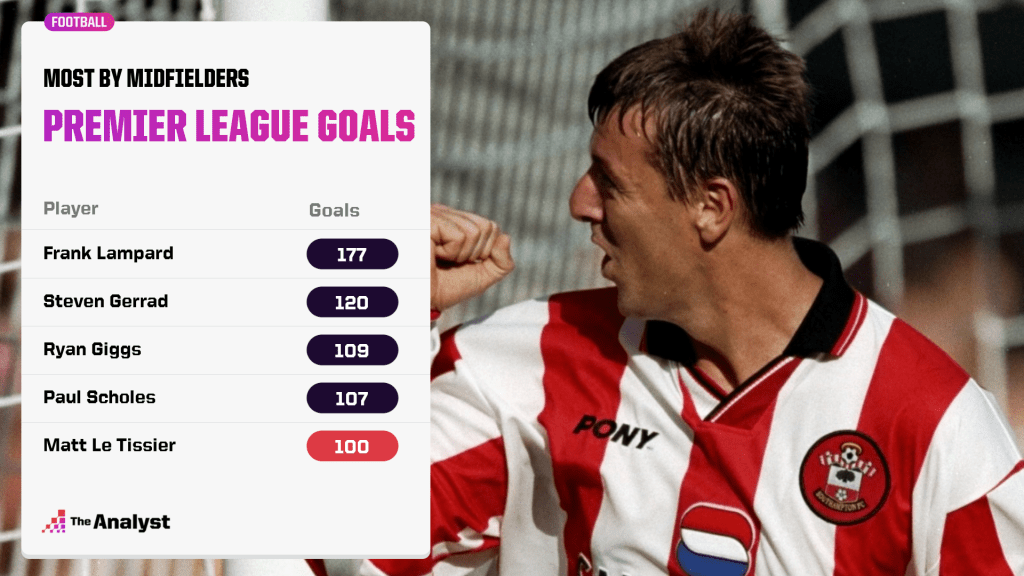
The goal was meaningful in other ways too. It wasn’t known at the time, because the dubious goals panel hadn’t yet taken a goal from a direct corner against Wimbledon in 1998 away from him, but this ultimately brought up his top-flight century in the Premier League era. Le Tissier was the first midfielder to reach the mark – a trailblazer for an illustrious group.
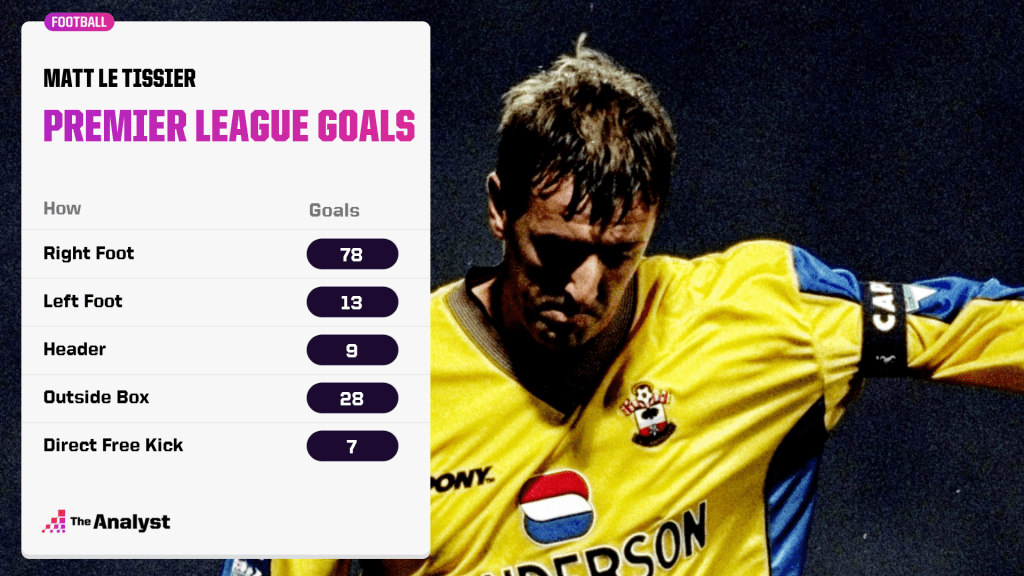
The Final One
Southampton 2-0 West Ham (January 30, 2002)
Le Tissier stuck around for the first season at St Mary’s, but the club had moved on. He made four substitute appearances, totalling just 45 minutes in the 2001-02 campaign. Only two of those appearances were at St Mary’s, the stadium that his performances had helped make a reality.
The last eight of those 45 minutes came on January 30, 2002, in a run-of-the-mill 2-0 home win over West Ham that proved noteworthy as the final act of the Premier League careers of two players. Imants Bleidelis, a Latvian midfielder recruited off the back of the success of the Pahars transfer, made his second and last appearance in a Saints shirt when he was brought on in the final minute.
One of those two substitutes would be given a testimonial – at which many grown men and women cried openly – and ultimately go on to serve as a club ambassador. The other has the distinction of having played fewer Premier League minutes for Southampton than anyone else who has represented the club in the competition, but didn’t come through the club’s academy (seven – just 20,667 fewer than Le Tissier).
Le Tissier is now synonymous with Southampton Football Club. It’s often said that we’ve moved away from a time when players will spend their entire career in one place, but the man himself has always insisted he would do the same again if he had his time over. And that loyalty didn’t earn him any trophies or the international recognition he deserved, but it does mean he’s one of only 16 players to score 100 Premier League goals for a single club.
100 Premier League Goals For A Single Club:
| Player | Team | Goals |
|---|---|---|
| Wayne Rooney | Manchester United | 183 |
| Sergio Agüero | Manchester City | 181 |
| Thierry Henry | Arsenal | 175 |
| Harry Kane | Tottenham Hotspur | 160 |
| Alan Shearer | Newcastle United | 148 |
| Frank Lampard | Chelsea | 147 |
| Robbie Fowler | Liverpool | 128 |
| Steven Gerrard | Liverpool | 120 |
| Michael Owen | Liverpool | 118 |
| Jamie Vardy | Leicester City | 115 |
| Alan Shearer | Blackburn Rovers | 112 |
| Ryan Giggs | Manchester United | 109 |
| Paul Scholes | Manchester United | 107 |
| Didier Drogba | Chelsea | 104 |
| Ian Wright | Arsenal | 104 |
| Matt Le Tissier | Southampton | 100 |
There were 31,879 people at St Mary’s to see that West Ham game – more than twice as many as had been there to bid farewell to The Dell. That is one of his legacies, having kept Southampton in the top-flight long enough to allow the new ground to be built and (eventually) paid for.
But that’s bricks and mortar, and to many fans – around the world – Le Tissier’s football is about much less tangible things: flair, artistry and rebellion; sticking to your principles and doing what makes you happy, while making a lot of others very happy in the process.
